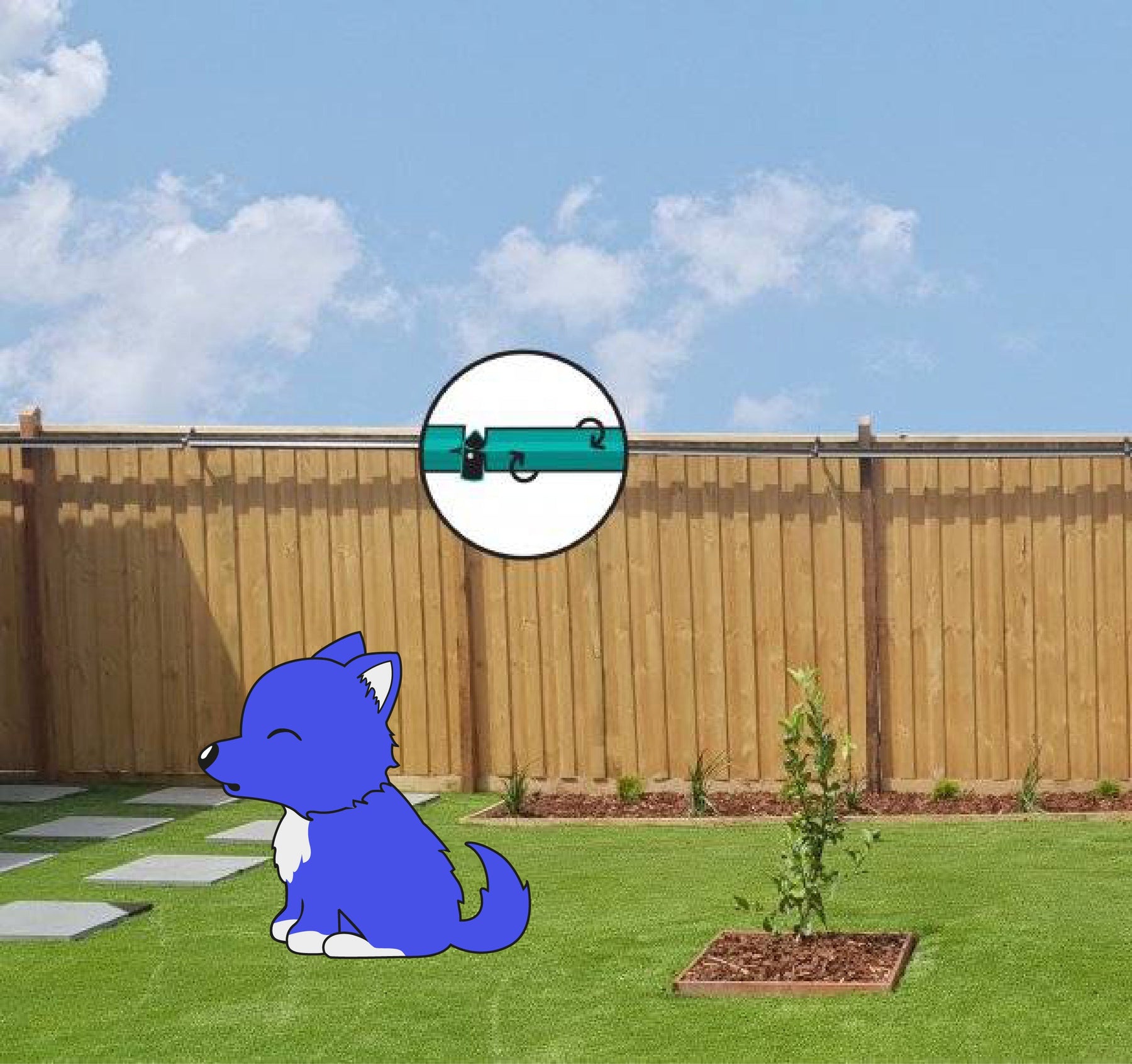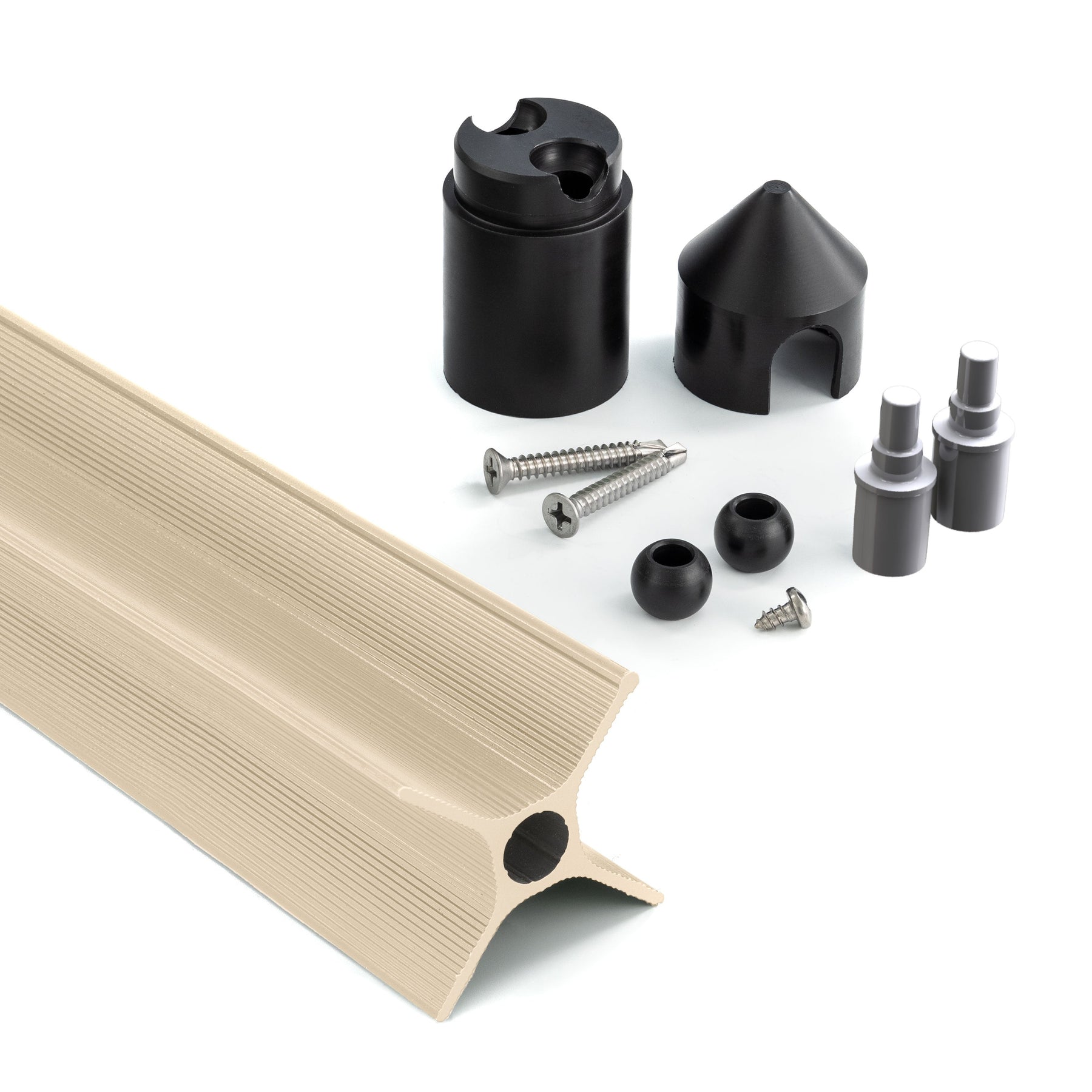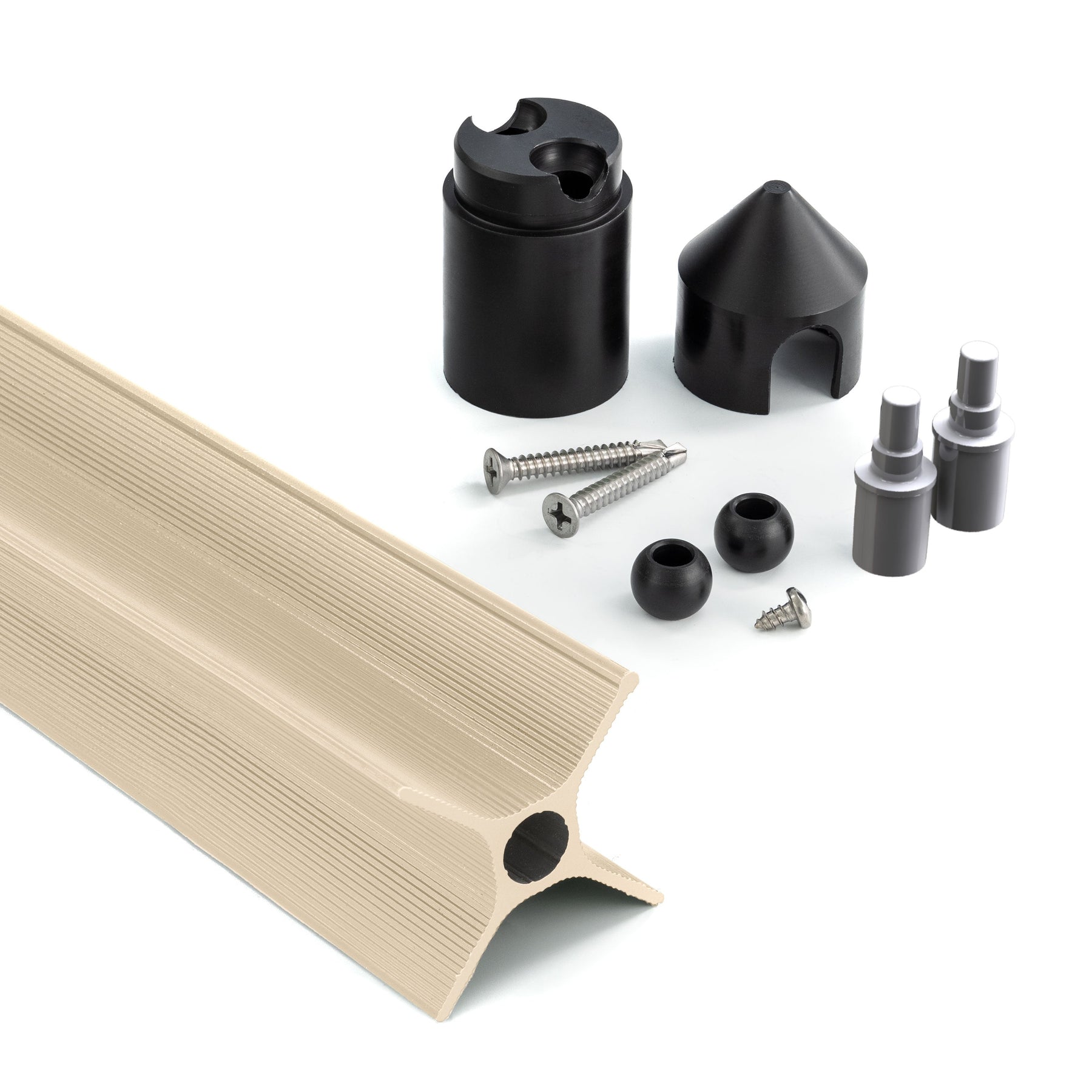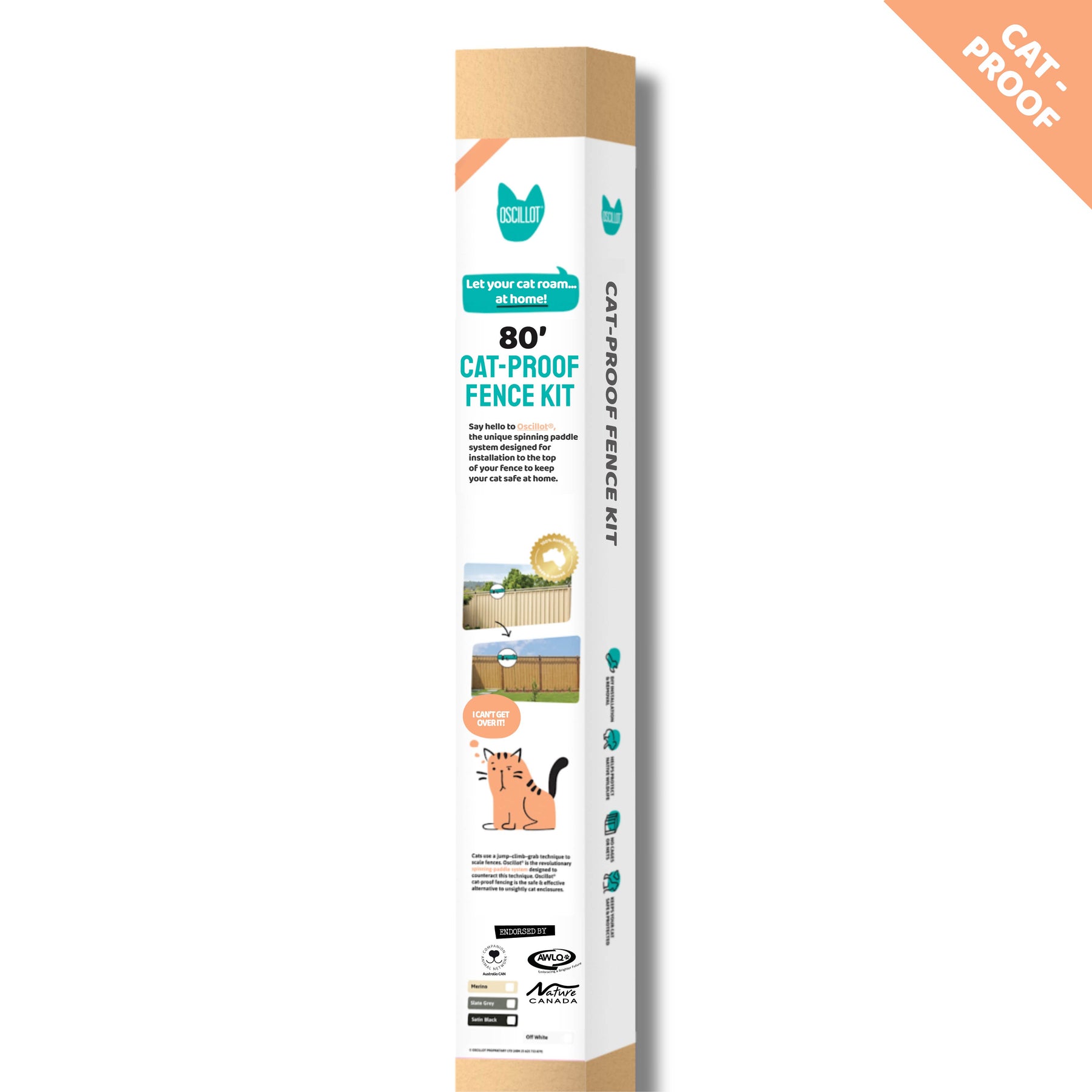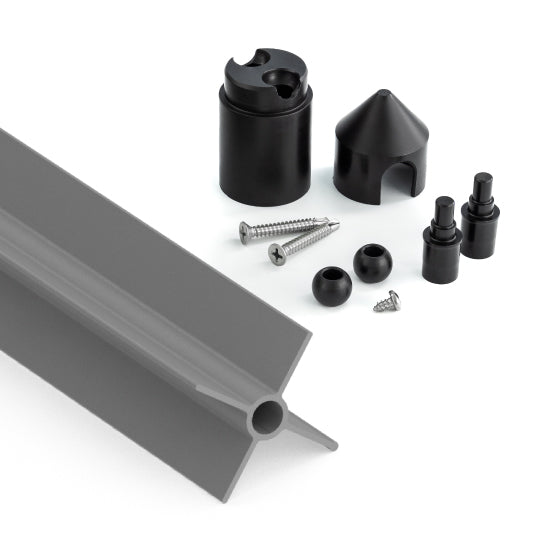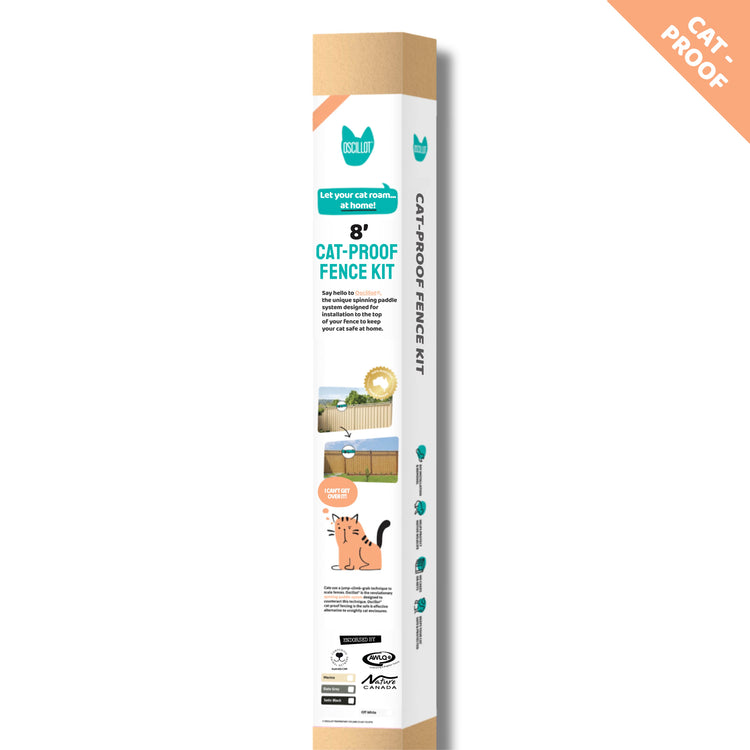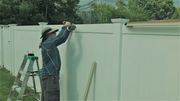Oscillot Kits for Irregular Yard Shapes: Complete Guide to Pet Containment Solutions

Key Takeaways About Oscillot Systems for Irregular Yards
- Oscillot kits can be adapted for any yard shape with the right planning and measurements
- Various kit sizes are available from 1.2 meters to 92.9 meters to accommodate different yard perimeters
- Both cat-proof and dog-proof options are available depending on your pet containment needs
- DIY installation is possible with proper planning and basic tools
- The rotating paddle system provides a humane solution for keeping pets within your property
- Special considerations are needed for corners, gates, and unusual fence features
- Professional installation services are available for complex configurations
- Regular maintenance ensures long-term effectiveness, especially in challenging yard layouts
- Multiple kits can be combined for extensive or particularly complex perimeters
- The system works with virtually any fence material including wood, metal, brick, and chain-link
Introduction to Oscillot Pet Containment Systems
If you have an irregularly shaped yard, keeping your pets safe and contained can feel like an impossible challenge. Traditional fencing solutions often fall short when dealing with unusual angles, curved boundaries, or yards with multiple sections. This is where Oscillot's innovative rotating paddle system comes to the rescue. These clever systems can be adapted to fit virtually any yard configuration, ensuring your furry friends remain safely contained regardless of how unique your property's layout might be. The adaptability of Oscillot makes it particularly valuable for homeowners with non-standard yard shapes who have struggled with conventional containment methods that simply weren't designed with irregular properties in mind.
Whether you have a cat that's determined to explore beyond your property boundaries or a dog that's mastered the art of fence jumping, Oscillot systems provide an effective, humane solution. The beauty of these systems lies in their flexibility - they can be installed on virtually any fence type and configuration, making them perfect for yards with unusual shapes and features. Unlike electric shock collars or buried wire systems that can cause stress or discomfort to your pets, Oscillot works through a simple mechanical principle that prevents climbing without any pain or distress to your beloved animals.
In this comprehensive guide, we'll explore how Oscillot kits can be adapted for irregular yard shapes, the various kit sizes available, installation considerations for challenging layouts, and tips for ensuring complete perimeter security regardless of your yard's unique features. By the end, you'll have all the information you need to create a safe outdoor space for your pets, no matter how irregular your yard may be. From L-shaped properties to multi-level gardens with terraced sections, we'll cover solutions for every type of yard configuration that might initially seem too challenging to secure effectively.
Understanding Oscillot's Rotating Paddle System
The secret to Oscillot's effectiveness lies in its super simple but clever rotating paddle system. Unlike electric fences that shock your pets or spike-based deterrents that can cause injury, Oscillot uses basic physics to prevent pets from gaining the leverage they need to climb over your fence. It's like trying to climb up a rolling log - just when your pet thinks they've got a grip, the paddle rotates and they slide right back down. This humane approach works on the principle that animals need a stable surface to push against when climbing, and by removing that stability, the system effectively prevents escape without causing any distress or discomfort to your beloved pets.
The system consists of three main parts that work together to create a secure barrier:
1. Rotating Paddles: These cylindrical rollers spin freely when touched, preventing pets from getting a good grip to climb over. For cats, these paddles are typically made of durable plastic, while the dog-proof fence kits feature stronger aluminum paddles designed to handle the extra strength of dogs. The paddles are engineered with precision bearings that ensure smooth rotation even after years of exposure to the elements, maintaining their effectiveness through all seasons and weather conditions.
2. Dual Knuckle Post Kits: These brackets secure the paddles to your fence, making sure they stay in place while still allowing the paddles to rotate freely when your pet tries to climb them. The dual knuckle design is crucial as it provides both the stability needed to support the system and the flexibility required for proper paddle rotation. The engineering behind these brackets ensures they can withstand the weight and pressure of pets attempting to climb without bending or breaking.
3. Connecting Components: These ensure you have a continuous barrier around your entire perimeter, including at corners and gates where pets often find weak spots. The connectors are designed to maintain the proper spacing between paddle sections while accommodating the unique features of your yard, such as changes in fence direction, height variations, or special features like gates and access points.
What makes this system so great for irregular yards is that each component can be adjusted and positioned to follow the unique contours of your property. The paddles can be cut to custom lengths for tight spaces, and the brackets can be mounted on almost any fence material - wood, metal, brick, or chain-link. This flexibility is key when dealing with yards that don't follow a simple square or rectangular shape. The modular nature of the Oscillot system means you can create custom configurations that perfectly match the unique layout of your property, ensuring complete coverage without gaps or weak points that clever pets might exploit.
Measuring Your Irregular Yard for Oscillot Installation
Before you can select the right Oscillot kit for your irregular yard, you'll need to get accurate measurements. This step is super important - good planning ensures you buy the right amount of materials and account for all the weird angles and features that make your yard unique. Think of it like measuring for custom furniture - you want to get it right the first time! Proper measurements are particularly crucial for irregular yards where standard calculation methods might not apply, and where underestimating could leave gaps in your security system that determined pets could exploit to escape.
Here's a simple step-by-step process to measure your irregular yard:
1. Create a Sketch: Start by drawing a rough outline of your yard on paper. Don't worry about making it perfect - just note all the fence sections, gates, and any unusual features like curves or sharp angles. This visual reference will be super helpful later. For particularly complex yards, consider taking photos of each section to reference during planning and installation. Some homeowners even find it helpful to use satellite imagery from mapping services to get a clear overhead view of their property's shape.
2. Measure Each Straight Section: Using a measuring tape, determine the length of each straight fence section. For an irregular yard, you'll likely have multiple sections of different lengths. Write each measurement on your sketch. For very long sections, consider enlisting a helper to hold one end of the tape measure, or use a laser measuring tool for greater accuracy. Be sure to measure along the top of the fence where the Oscillot system will be installed, not just along the ground.
3. Account for Corners: For each corner in your yard, add an extra 30cm to your measurements. Corners require special attention during installation, and having this extra material will make the process much easier. Different corner angles may require slightly different approaches - right angles (90 degrees) are straightforward, but acute angles (less than 90 degrees) or obtuse angles (greater than 90 degrees) might need additional consideration during installation.
4. Note Special Features: Make a list of areas where your fence changes height, uses different materials, or has gaps that might need special attention. These details will affect how you install your Oscillot system. Also note any nearby trees, utility poles, or structures that pets might use as alternative climbing routes to bypass your fence system. These might need additional consideration in your overall containment strategy.
If you're finding the measurement process tricky, don't worry! You can visit our detailed guide on measuring your yard or use our handy cat fence calculator to help figure out exactly how much material you'll need. These resources provide step-by-step assistance tailored specifically to the challenges of measuring irregular properties.
Remember that irregular yards often need more components to navigate corners, curves, and changes in elevation. A good rule of thumb is to add 10-15% extra material to your calculated total to account for these irregularities and make sure you have enough for the complete installation. It's better to have a little extra than to run short halfway through your project! This buffer will save you the frustration and delay of having to order additional components if you discover unexpected challenges during installation.
Selecting the Right Oscillot Kit Size for Your Yard
Oscillot offers a range of kit sizes to fit yards of all shapes and dimensions. For irregular yards, you might need to combine multiple kits or select a larger kit that can be customized to your specific layout. Let's look at the options available to help you make the best choice for your unique situation. Having the right amount of material is crucial for ensuring complete perimeter security without unnecessary expense, especially when working with non-standard yard configurations that might require creative solutions.
For cat owners, we offer a variety of cat-proof fence kit sizes to accommodate different yard dimensions:
• 1.2 Metre Kit (€40.00): This is our smallest kit, perfect for adding protection to a small section or supplementing larger kits for those odd corners and irregular areas. It includes one paddle and two dual knuckle post kits, making it ideal for securing small gaps or adding extra protection to vulnerable spots in your perimeter.
• 3.7 Metre Kit (€88.00): Great for small yards or specific problem sections where your cat keeps escaping. This kit includes 3 paddles and 4 dual knuckle post kits. It's an excellent choice for townhouses, small urban gardens, or as a supplement to larger kits when you need to secure additional sections of your irregular yard.
• 6.2 Metre Kit (€190.00): A mid-sized option suitable for medium yards or extensions. It provides enough material to secure a significant portion of your perimeter. With 5 paddles and 6 dual knuckle post kits, this option offers good value for courtyard-sized properties or for securing specific vulnerable sections of larger yards.
• 12.4 Metre Kit (€288.00): This popular kit covers substantial yard sections with 10 paddles and 13 dual knuckle post kits, making it a good choice for larger irregular yards. Many customers with medium-sized properties find this kit provides sufficient coverage for their entire perimeter, with enough flexibility to handle multiple corners and angles.
• 24.8 Metre Kit (€544.00): Designed for larger yard perimeters, this kit provides extensive coverage for most standard-sized properties. With 20 paddles and 25 dual knuckle post kits, it offers comprehensive protection for properties with complex boundaries and multiple fence sections.
• 31 Metre Kit (€680.00): Our comprehensive kit offers enough material to secure most average-sized yards completely. This kit includes 25 paddles and 31 dual knuckle post kits, providing ample coverage for properties with numerous corners, angles, and irregular features that require additional material.
• 92.9 Metre Kit (€1,943.00): Our most extensive option, perfect for very large properties with complex perimeters. With 75 paddles and 92 dual knuckle post kits, this comprehensive solution can handle even the most extensive and irregular yard configurations, including properties with multiple separate fenced areas.
For dog owners, we offer specialized dog-proof fence kits with reinforced components:
• 1.2 Metre Kit (€57.00): Features reinforced aluminum paddles specifically designed to withstand the strength of dogs. The enhanced durability makes this small kit perfect for securing vulnerable sections where your dog has previously escaped or shown interest in climbing or jumping.
• 2.5 Metre Kit (€97.00): A popular choice for small to medium dogs, with enhanced durability for active pets. This kit provides enough material to secure small sections like gates or specific problem areas where your dog has demonstrated escape behaviors in the past.
• 3.7 Metre Kit (€170.00): Includes reinforced knuckles and aluminum paddles specifically designed for containing dogs in medium-sized areas. The heavy-duty components can withstand the weight and strength of larger breeds, making it suitable for securing sections where powerful dogs might test the boundaries.
For irregular yards, I recommend calculating your total perimeter and then selecting a combination of kits that slightly exceeds your measurement. This ensures you'll have enough materials to account for corners, curves, and any adjustments needed during installation. For example, if your irregular yard has a perimeter of about 15 meters, you might choose a 12.4-meter kit plus a 3.7-meter kit to make sure you're fully covered. This approach provides the flexibility to address unexpected challenges that often arise when working with non-standard yard configurations.
All our kits include our comprehensive 3-year warranty and 60-day money-back guarantee, so you can buy with confidence knowing your investment is protected even if your yard presents some unexpected challenges during installation. This warranty covers manufacturing defects and ensures that your system will continue to perform effectively through seasonal changes and normal weather conditions.
Installation Considerations for Irregular Yard Shapes
Installing Oscillot on irregular yard shapes requires careful planning and some special techniques. Unlike a simple square or rectangular yard, irregular shapes present unique challenges that you'll need to address for a successful installation. Let's look at the key considerations to ensure your system works effectively regardless of your yard's unique configuration. The extra attention to detail during installation will pay dividends in the long-term effectiveness of your pet containment system, preventing the frustration of having to address escape points after your pets discover them.
Irregular yards often have lots of corners and unusual angles. When installing Oscillot around these corners, here's what you need to do:
1. Position Knuckles Strategically: Place dual knuckle post kits approximately 10-15cm from each corner. This provides stability while allowing the paddles to effectively cover the corner area. The precise positioning may vary depending on the angle of the corner - sharper angles might require knuckles to be placed slightly closer to ensure proper support and coverage.
2. Cut Paddles if Necessary: For tight angles, you might need to cut the paddles to fit precisely. Use a fine-toothed saw for this job, and don't forget to sand the edges smooth afterward to prevent any sharp edges. When cutting paddles, measure twice to ensure accuracy, as improper cuts can lead to gaps in your security system or difficulties in installation. A hacksaw or fine-toothed handsaw works well for plastic paddles, while a metal-cutting saw is recommended for aluminum dog-proof paddles.
3. Add Extra Support: Corners often need additional brackets for stability, especially in areas with high wind exposure. Don't skimp on support here - corners are often where pets first look for escape routes! In particularly challenging corners, consider doubling up on brackets to ensure the system remains secure even under pressure from determined pets or adverse weather conditions.
Many irregular yards also have sections where the fence height changes or where the ground slopes. Here's how to handle these elevation changes:
1. Step Installation: Install paddles in a stepped pattern that follows the slope gradient. This maintains effective coverage while accommodating the natural contours of your yard. For gradual slopes, steps of approximately 10-15cm work well, while steeper slopes might require smaller increments to maintain consistent security.
2. Maintain Consistent Height: Try to keep the top of the paddle system at a consistent height from the ground. This ensures your pet can't find a lower section to attempt an escape. The recommended height is at least 1.8 meters from ground level to the top of the Oscillot system, accounting for any changes in ground elevation throughout your yard perimeter.
3. Fill Gaps: Use additional materials to fill any gaps created by elevation changes. Even small openings can provide escape opportunities for determined pets. Mesh panels, additional paddle sections, or other barrier materials can be used to close gaps where the standard Oscillot components might not provide complete coverage due to terrain irregularities.
Irregular yards often incorporate multiple fence types as well. Our comprehensive installation guide provides specific instructions for mounting on wood fences, chain-link fences, brick and masonry walls, metal fences, and vinyl fencing. Each material requires slightly different mounting techniques, but the Oscillot system is designed to be adaptable to virtually any fence type. For wooden fences, standard screws work well; for chain-link, special brackets are available; for masonry, masonry anchors provide secure attachment points.
Gates and access points need special attention too, especially in irregular yards that might have multiple entry points:
1. Removable Sections: For gates that are frequently used, consider creating removable paddle sections that can be easily detached when needed. Quick-release brackets or hinged systems can provide security while maintaining convenient access for humans. These specialized solutions allow the gate to function normally while ensuring pets remain contained when the gate is closed.
2. Gate Height: Make sure your gates are tall enough to accommodate the Oscillot system. Sometimes gates are shorter than the surrounding fence, creating a potential weak point. If necessary, extend your gate height before installing the Oscillot components to maintain consistent protection around your entire perimeter.
3. Secure Latches: Upgrade your gate latches to prevent pets from pushing gates open. This is especially important for dogs, who are often clever about manipulating simple latches. Self-closing mechanisms and two-stage latches provide additional security against determined escape artists who have learned to exploit standard gate hardware.
Solutions for Specific Irregular Yard Challenges
Irregular yards come with unique challenges that require specific solutions. Whether your yard has curved sections, split levels, or other unusual features, there's a way to adapt the Oscillot system to work effectively. Let's explore some common irregular yard scenarios and how to address them. These targeted approaches will help you overcome the specific obstacles presented by your unique yard configuration, ensuring complete containment without compromising on aesthetics or functionality.
Many irregular yards feature curved fence lines that can be tricky to fit with standard straight paddles. Here's how to handle these curved sections:
1. Multiple Short Sections: Use shorter paddle sections placed side by side to follow the curve. Think of it like making a curve with straight lines - the shorter the sections, the smoother the curve will appear. For gentle curves, standard 1.2-meter sections often work well, while tighter curves might require custom-cut sections as short as 30-50cm to achieve a smooth contour that follows your fence line precisely.
2. Custom Angle Adjustments: Adjust the angle of each knuckle slightly to accommodate the curve. The flexible design of the knuckles allows for these minor adjustments. By rotating each bracket a few degrees from the previous one, you can create a gradual curve that follows your fence line naturally. This approach works particularly well for large-radius curves where the change in direction is subtle.
3. Gap Management: Make sure there are no gaps larger than 3cm between paddle sections along curves. Cats especially are experts at finding even the smallest openings! Use overlapping paddle placements where necessary to eliminate gaps, and consider adding extra brackets in areas where the curve is particularly pronounced to prevent paddles from shifting over time.
For yards with multiple levels or terraced sections, try these approaches:
1. Sectional Installation: Treat each level as a separate installation section. This allows you to maintain the correct height relationship between the fence top and the ground on each level. Begin by securing the highest level first, then work your way down to ensure proper overlap and eliminate potential climbing routes between levels.
2. Junction Points: Pay special attention to where different levels meet, ensuring continuous coverage. These transition points often create vulnerabilities if not properly addressed. Use additional brackets and custom-cut paddles to create seamless transitions between levels, eliminating any gaps or steps that pets might exploit as climbing aids.
3. Vertical Barriers: In some cases, you might need vertical paddle sections at level changes to prevent pets from finding an easier climbing route. These vertical installations can be particularly effective where retaining walls or steep grade changes create potential bypass routes that would otherwise circumvent your horizontal paddle system.
Trees or posts along the fence line require special consideration too:
1. Paddle Cuts: Custom-cut paddles to fit around tree trunks or posts. Measure carefully and make precise cuts to ensure a snug fit. For irregular shapes like tree trunks, consider creating templates from cardboard first to test your measurements before cutting the actual paddles. This extra step can prevent costly mistakes and ensure a precise fit around challenging obstacles.
2. Tree Growth: For growing trees, allow extra space to accommodate future growth. You don't want to have to reinstall the system as the tree expands. Consider using flexible connectors or expansion joints in these areas that can adapt as the tree grows, preventing damage to both the tree and your containment system over time.
3. Supplemental Barriers: For very large trees that might serve as escape routes, consider additional deterrents to prevent climbing. Smooth metal bands wrapped around tree trunks or specialized tree guards can prevent pets from using trees as alternative escape routes that bypass your fence system entirely.
Yards with water features or pond boundaries present unique challenges:
1. Extended Overhangs: Install paddles with a greater overhang over water areas to ensure pets can't use the water as a way to bypass the system. The standard overhang might need to be increased by 10-15cm in these areas to compensate for the changing water levels and the inability to extend barriers below the water surface.
2. Weather-Resistant Components: Use our aluminum components for areas with high moisture exposure to prevent corrosion and ensure longevity. While all Oscillot components are designed for outdoor use, the aluminum options provide superior resistance to constant moisture exposure, making them ideal for installation near ponds, pools, or in coastal areas with salt spray.
3. Regular Inspection: Schedule more frequent checks of water-adjacent sections for stability, as moisture can affect mounting hardware over time. Quarterly inspections are recommended for standard installations, but water-adjacent sections should be checked monthly to catch any early signs of corrosion or loosening that might compromise system effectiveness.
Our 31 Metre Cat-Proof Fence Kit (€680.00) is particularly popular for irregular yards because it provides enough material to cover most standard perimeters while offering flexibility for custom adaptations to unusual features. The comprehensive kit includes everything you need to secure even the most challenging yard configurations, with sufficient extra components to address unexpected issues that often arise during installation in complex environments.
Combining Multiple Oscillot Kits for Complex Yard Layouts
For yards with highly irregular shapes or extensive perimeters, combining multiple Oscillot kits often provides the most cost-effective and efficient solution. This approach gives you the flexibility to address different sections of your yard with the most appropriate components. By strategically selecting combinations of kit sizes, you can ensure complete coverage without unnecessary waste, tailoring your solution precisely to your property's unique requirements.
Here are some smart approaches to combining kits for complex layouts:
1. Section-by-Section Installation: Divide your yard into logical sections based on fence type, height, or shape, and select appropriate kit sizes for each. For example, you might use a smaller kit for a decorative garden section and a larger kit for the main perimeter. This targeted approach allows you to allocate resources efficiently, using more robust components in high-risk areas where pets frequently test boundaries while using standard components in less vulnerable sections.
2. Base Kit Plus Supplements: Start with our largest kit (like the 92.9 Metre Cat-Proof Fence Kit at €1,943.00) for the main perimeter, then add smaller kits for special features or challenging areas. This approach ensures you have plenty of material for the bulk of your installation while allowing for customization where needed. The larger kit provides economies of scale for the majority of your perimeter, while smaller supplementary kits address specific challenges without requiring you to purchase excessive quantities of specialized components.
3. Modular Expansion: If budget is a concern, you can start by securing the most vulnerable sections of your yard first, then expand your system over time. This phased approach lets you spread the cost while still providing some immediate protection. Many customers begin by securing areas where their pets have previously escaped or shown particular interest in exploring, then gradually extend protection around the entire perimeter as budget allows.
When combining kits, it's important to ensure seamless connections between sections:
1. Consistent Paddle Height: Maintain the same height for all paddle sections around the perimeter. This prevents creating an obvious "weak spot" where your pet might focus escape attempts. Even if your fence height varies, try to keep the top of the paddle system at a consistent height relative to the ground to maintain uniform protection throughout your perimeter.
2. Secure Joints: Use connector pieces to ensure no gaps exist between kit sections. Even small gaps can provide escape opportunities, especially for determined cats. Where standard connectors don't provide a perfect fit due to unusual angles or features, custom connector solutions can be created using cut paddle sections or specialized brackets to ensure continuous protection.
3. Uniform Appearance: Try to match paddle colors and styles for a cohesive look. While function is the primary concern, a uniform appearance helps the system blend with your landscaping. This aesthetic consideration is particularly important for front yards or areas visible from the street, where maintaining your property's visual appeal might be a priority alongside pet containment.
For extremely irregular yards, some customization may be necessary:
1. Paddle Cutting: Paddles can be safely cut to custom lengths using a fine-toothed saw. Just be sure to sand the cut edges smooth to prevent damage to the system or injury to your pets. For plastic paddles, a hacksaw works well, while aluminum paddles in dog-proof systems might require a metal-cutting blade. Always wear appropriate safety gear including eye protection and gloves when cutting components.
2. Bracket Adjustments: Knuckle positions can be modified slightly for unusual fence configurations. The brackets have some flexibility in how they're mounted, allowing for adaptation to various situations. In some cases, you might need to create custom mounting solutions for non-standard fence materials or unusual structural elements that don't accommodate standard bracket positioning.
3. Special Order Components: For truly unique situations, contact our customer service about special order components that might better suit your specific needs. Our team has experience with a wide range of unusual installations and can often suggest specialized solutions for particularly challenging yard features that standard components might not adequately address.
Our 12.4 Metre Cat-Proof Fence Kit (€288.00) is particularly popular as a supplementary kit for adding to larger installations or addressing specific problem areas in irregular yards. Its moderate size provides enough material to secure substantial sections while remaining cost-effective. Many customers find this mid-sized kit strikes the perfect balance between providing sufficient components for meaningful coverage while maintaining budget flexibility.
Maintenance Considerations for Oscillot Systems on Irregular Yards
Maintaining your Oscillot system is essential for long-term effectiveness, particularly on irregular yards where unique features can create additional maintenance needs. A well-maintained system will continue to protect your pets for years to come, while neglected systems might develop weak points where escapes could occur. Irregular yards often experience uneven stress on containment systems due to their unique configurations, making regular maintenance even more critical than for standard rectangular yards.
Establishing a regular inspection schedule is the foundation of good maintenance:
1. Monthly Visual Checks: Walk your perimeter monthly to look for any obvious issues like loose brackets, damaged paddles, or areas where debris might have accumulated. This quick check only takes a few minutes but can catch problems before they become serious. Pay particular attention to corners, curves, and transition points between different fence types or heights, as these areas tend to experience more stress and may develop issues more quickly than straight sections.
2. Seasonal Deep Inspection: Four times a year, perform a more thorough inspection, particularly after extreme weather events like heavy storms or high winds. Pay special attention to mounting hardware and connection points. Test each paddle to ensure it rotates freely, and check that all brackets remain securely fastened to your fence. This seasonal check should coincide with changes in weather patterns that might affect your system's performance.
3. Problem Area Focus: In irregular yards, some areas naturally need more attention than others. Corners, curves, and elevation changes are more likely to develop issues over time, so check these areas more carefully. Create a "maintenance map" of your yard highlighting these high-priority sections to ensure they receive the extra attention they require during each inspection cycle.
Common maintenance tasks include:
1. Paddle Cleaning: Remove leaves, spider webs, dirt, or other debris that might affect the paddles' ability to rotate freely. A simple wipe with a damp cloth is usually sufficient. For stubborn grime, a mild soap solution can be used, but avoid harsh chemicals that might damage the plastic or aluminum components. In wooded areas or seasons with heavy pollen, more frequent cleaning may be necessary to maintain optimal performance.
2. Bracket Tightening: Check and tighten any loose brackets, especially at corners where movement is more likely. Over time, vibration and weather can cause fasteners to loosen slightly. Use the appropriate tool for your bracket type - typically a screwdriver for wood fence installations or a wrench for metal fence hardware. Consider applying thread-locking compound to fasteners in areas that repeatedly come loose due to vibration or movement.
3. Lubrication: If you notice the paddles becoming stiff or difficult to rotate, apply a small amount of silicone spray to the paddle axles. Don't use oil-based lubricants as they can attract dirt and grime. A light application once or twice a year is typically sufficient, but areas exposed to salt air or high humidity might require more frequent treatment to prevent sticking.
4. Damage Repair: Address any damage promptly to maintain system integrity. Replace cracked or broken paddles, and repair or replace damaged brackets as soon as you notice them. Keeping spare components on hand allows for immediate repairs when issues are discovered, preventing temporary weak points that clever pets might exploit before replacement parts arrive.
Different seasons present unique challenges for irregular yards:
1. Winter Preparation: In areas with snow, ensure paddles can rotate freely despite snow accumulation. You may need to occasionally clear snow that builds up around the system. Check that freezing temperatures haven't caused any components to become brittle or crack, particularly in plastic parts exposed to extreme cold. Consider applying a weather-resistant lubricant before winter to prevent freezing of moving parts.
2. Spring Growth: Check for and trim back new plant growth that might interfere with the system. Vines and climbing plants are particularly problematic as they can restrict paddle movement. Establish a clear zone of at least 15cm around your Oscillot system to prevent vegetation from impeding its function. This is especially important in irregular yards where landscaping might be more varied and complex.
3. Summer Heat: In extremely hot climates, check that plastic components haven't warped or become brittle from UV exposure. Our materials are UV-stabilized, but extreme conditions can still have an effect over time. Consider providing shade for sections in direct, intense sunlight if you notice any signs of UV degradation. This is particularly relevant for south-facing fence sections that receive maximum sun exposure.
4. Fall Debris: Clear fallen leaves that may accumulate in corners or curves. These can not only prevent proper paddle rotation but can also provide climbing assistance to pets if allowed to pile up. Irregular yards often have more nooks and corners where debris can collect, requiring more diligent clearing than might be necessary for simpler yard shapes.
Our blog post on securing your garden during storm season provides additional tips for maintaining your Oscillot system during extreme weather, which is particularly relevant for irregular yards where water flow and debris accumulation may be unpredictable. These specialized guidelines can help protect your investment during challenging weather conditions that might otherwise compromise system effectiveness.
Customer Success Stories with Irregular Yard Installations
Many of our customers have successfully installed Oscillot systems on challenging, irregular yard configurations. Their experiences provide valuable insights and inspiration for your own installation project. These real-world examples show how the system can be adapted to even the most unusual yard shapes. Learning from others who have overcome similar challenges can help you approach your own installation with confidence, armed with practical solutions that have been proven effective in comparable situations.
Case Study: L-Shaped Yard with Multiple Fence Types
Maria from Amsterdam installed our 24.8 Metre Cat-Proof Fence Kit on her L-shaped yard that featured both wooden and brick fence sections:
"I was worried that my yard's unusual shape would make it impossible to secure properly, but the flexibility of the Oscillot system allowed me to secure my L-shaped yard without any issues. I used different mounting techniques for the wooden and brick sections, and the system works perfectly. My three cats haven't escaped once since installation! The corners were tricky, but the extra brackets I added have kept everything secure even during stormy weather. I particularly appreciated the detailed instructions for different fence materials, which made it possible to create a seamless barrier despite the varying fence construction around my property."
Case Study: Sloped Yard with Terraced Sections
Thomas from Berlin tackled a challenging sloped yard with three distinct terraced sections:
"My yard has three different levels with retaining walls between them, which made it seem impossible to secure. I combined the 12.4 Metre Kit with two 6.2 Metre Kits to cover all the sections. The key was treating each level separately and paying special attention to the transition points where the terraces meet. The installation took a full weekend, but it was worth every minute. My adventurous tabby, Max, used to scale the fence at the lowest terrace, but now he can't get past the rotating paddles. The stepped installation looks natural and doesn't detract from the garden's appearance at all."
Case Study: Curved Boundary with Water Feature
Sarah from Edinburgh had a unique challenge with her curved fence line that bordered a pond:
"Our backyard has a beautiful curved fence that follows the natural contours of our pond, but it was impossible to secure with traditional methods. I was concerned about both my cats' safety and the integrity of our water feature. Using multiple sections from our 31 Metre Kit, I was able to create a smooth curve that follows the fence line perfectly. The aluminum components have held up beautifully despite the constant moisture from the pond. I cut shorter paddle sections and used extra brackets to achieve the curve, and the result looks like it was custom-made for our space. Our cats can still enjoy watching the fish from inside the yard, but they can no longer take an unwanted swimming lesson!"
Case Study: Multi-Level Property with Variable Fence Heights
Jean-Pierre from Lyon dealt with a complex property featuring multiple fence heights and materials:
"Our property is built on a hillside with different fence sections at various heights - some wooden panels are 1.5 meters, others are 2 meters, and we have a brick wall section that's nearly 3 meters high. The varying heights made it challenging to create consistent protection. I used our comprehensive 92.9 Metre Kit and carefully planned the installation to maintain the same relative height from the ground throughout. The result is a system that provides uniform security despite the irregular fence heights. My two Bengal cats are excellent climbers, but they haven't found a way past the system yet. The planning phase took some time, but the detailed measurement guides made it manageable even for someone like me who isn't particularly handy."
Case Study: Urban Courtyard with Multiple Access Points
Anna from Copenhagen transformed her narrow urban courtyard with multiple gates and entrances:
"Living in the city center means our yard is a narrow, irregular space with three different gates for various access needs. Each gate is a different height and style, which made traditional containment impossible. I started with a 12.4 Metre Kit and added two 3.7 Metre Kits to handle all the gate areas and corners. The removable sections I created for the most-used gate work perfectly - I can detach them in seconds when I need vehicle access, but they provide complete security when installed. My indoor cats can now safely enjoy our small courtyard space without the risk of escaping into busy city streets."
These success stories demonstrate that with proper planning and the right combination of Oscillot components, even the most challenging irregular yard configurations can be effectively secured. Each customer found creative solutions to their unique challenges while maintaining both the functionality and aesthetics of their outdoor spaces.
Visit our customer reviews page to read more success stories and see additional photos of installations on irregular yard shapes. These real-world examples can provide inspiration and practical ideas for your own project, showing how other pet owners have overcome challenges similar to yours.
Cost Considerations and Budget Planning
Planning the budget for an Oscillot installation on an irregular yard requires careful consideration of both the basic kit costs and potential additional components needed for your unique configuration. While irregular yards might require more materials and planning than simple rectangular spaces, the investment in a complete, effective system pays dividends in peace of mind and pet safety. Understanding all the potential costs upfront helps you make informed decisions and avoid surprises during your installation project.
Here's a breakdown of typical costs for irregular yard installations:
Base Kit Costs:
• Small installations (up to 15 meters): €88-€288 using single kits or combinations of smaller kits
• Medium installations (15-35 meters): €288-€680 typically requiring our larger single kits or strategic combinations
• Large installations (35+ meters): €680-€1,943 for comprehensive coverage of extensive irregular perimeters
Additional Components for Irregular Yards:
• Extra brackets for complex corners: €15-€45 depending on the number of challenging angles
• Supplementary small kits for gap filling: €40-€88 for areas that don't fit standard measurements
• Specialized mounting hardware for unusual fence materials: €20-€60 for brick, stone, or metal fence adaptations
Tools and Installation Supplies:
Most installations require basic tools you might already own: drill, screwdrivers, measuring tape, level, and safety equipment. For irregular yards, you might also need:
• Fine-toothed saw for cutting paddles to custom lengths: €25-€50
• Masonry bits and anchors for brick or stone sections: €15-€30
• Additional fasteners and connectors: €10-€25
Professional Installation Costs:
While Oscillot systems are designed for DIY installation, complex irregular yards might benefit from professional installation. Costs vary by region but typically range from €200-€500 for standard installations, with irregular configurations potentially adding €100-€200 due to the additional planning and customization required.
Our fence calculator can help you estimate the basic kit requirements for your yard, though irregular shapes may require manual adjustments to the calculated amounts. It's always better to slightly overestimate your needs rather than fall short during installation.
Cost-Saving Strategies for Irregular Yards:
1. Phased Installation: Secure the most vulnerable sections first, then expand the system as budget allows. This approach lets you immediately address escape-prone areas while spreading costs over time.
2. Kit Combinations: Sometimes combining smaller kits is more cost-effective than purchasing one large kit, especially when you need specific amounts for irregular sections.
3. DIY Installation: The comprehensive guides and customer support make self-installation feasible for most homeowners, saving significantly on labor costs.
4. Long-term Value: Consider the lifetime cost comparison with alternatives like electric fencing (which requires ongoing power costs) or professional pet-sitting services when you're concerned about escapes.
All Oscillot purchases are protected by our 3-year comprehensive warranty and 60-day money-back guarantee, ensuring your investment is protected even if your irregular yard presents unexpected challenges during installation. This warranty coverage provides additional value and peace of mind, particularly important when dealing with complex installations that might face unique stresses.
Getting Started with Your Irregular Yard Oscillot Project
Now that you understand how Oscillot systems can be adapted for irregular yard shapes, it's time to begin planning your specific installation. The process might seem complex initially, but breaking it down into manageable steps makes it much more approachable. Whether you're dealing with curved boundaries, multiple levels, or unusual angles, a systematic approach will ensure your success.
Step 1: Assessment and Planning
Begin by thoroughly documenting your yard's unique features. Take photos from multiple angles, create a detailed sketch, and note all the challenges you'll need to address. Identify escape-prone areas, problem corners, and any features that might require special attention during installation.
Step 2: Precise Measurement
Use our comprehensive measurement guide to accurately determine your perimeter requirements. For irregular yards, measure each section separately and add the recommended buffer for corners and customization needs.
Step 3: Kit Selection
Based on your measurements and budget, choose the appropriate combination of kits. Remember that it's better to have slightly more material than you need rather than running short during installation. Our customer service team can help verify your kit selection if you're unsure.
Step 4: Pre-Installation Preparation
Gather all necessary tools, clear the work area, and review the installation instructions thoroughly. For irregular yards, consider creating a detailed installation plan that addresses each unique section separately.
Step 5: Installation
Follow our detailed installation guides, taking extra time with challenging sections. Don't rush this phase - careful installation ensures long-term effectiveness and reduces maintenance needs.
Step 6: Testing and Adjustment
After installation, test the system thoroughly. Check that all paddles rotate freely, ensure there are no gaps larger than 3cm, and verify that corner connections are secure. Make any necessary adjustments before considering the installation complete.
Expert Support Available
Remember that you're not alone in this project. Our experienced customer service team has helped thousands of customers with irregular yard installations. Don't hesitate to contact us if you encounter challenges or need advice specific to your unique situation.
Whether you're dealing with an L-shaped yard, terraced levels, curved boundaries, or any other irregular configuration, the Oscillot system can be adapted to provide complete, effective pet containment. The investment in proper planning and quality components will provide years of peace of mind, knowing your beloved pets are safe and secure in their outdoor space.
Ready to get started? Browse our full range of cat-proof fence kits or explore our specialized dog-proof options to find the perfect solution for your irregular yard. Your pets' safety and your peace of mind are worth the investment in a proper, professional-grade containment system.
Transform your challenging irregular yard into a safe paradise for your pets with Oscillot - because every pet deserves secure outdoor freedom, regardless of your property's unique shape!




